WEST VALLEY, N.Y. – In a project that saves taxpayer money, cleanup crews refurbished a former storage facility for waste disposal operations during the teardown of the Main Plant Process Building at the West Valley Demonstration Project ( WVDP).
EM and cleanup contractor CH2M HILL BWXT West Valley completed modifications to the onsite storage facility for use in preparing containers of demolition waste for loading and shipment to an offsite disposal location. Starting demolition of the Main Plant is an EM 2022 priority.
“The modifications to this facility demonstrate ingenuity and vision. Repurposing a facility for future work saves taxpayers money while maintaining our high safety and quality standards,” EM WVDP Director Bryan Bower said. “The safe completion of projects like this continues to bring us closer towards the future demolition of the Main Plant Process Building. I am proud of the work of our employees as we continue our cleanup mission at the site.”
 |
|
An operator at the West Valley Demonstration Project uses an excavator to remove a large concrete shield wall to create an entrance to accommodate a large fork truck for transporting empty waste containers in and out of the building. |
Workers at the West Valley Demonstration Project place concrete for a new floor inside a former storage facility. |
|
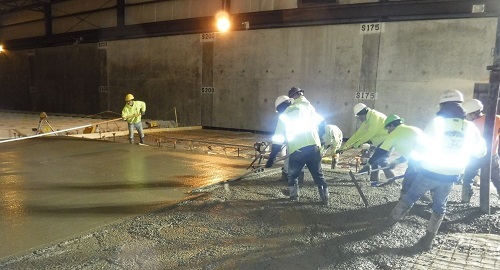 |
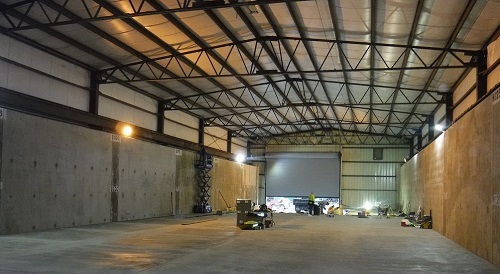 |
|
Crews renovate a former storage facility for waste disposal operations at the West Valley Demonstration Project. A new roll-up door is in the background. |
A new roll-up door is installed on a former storage facility at the West Valley Demonstration Project. |
|
 |
Workers removed nearly 300 concrete curbs that previously supported storage operations at the facility prior to its transformation. They also took out a large concrete shield wall to make an entrance for a large fork truck that will transport intermodal waste containers in and out of the building. Crews also installed a large roll-up door, placed concrete for two ramps and a new floor, completed repairs to an overhead crane inside the building, and added three small access doors.
The 17,250-square-foot former storage facility was constructed in 1987 for remote loading, placement and shielded storage of about 20,000, 71-gallon square drums of waste generated from previous operations. The drums were later removed from the building and shipped by train to a low-level waste disposal facility.
The five-story, 35,000-square-foot Main Plant was constructed in the 1960s as a commercial reprocessing facility to recover reusable plutonium and uranium from spent nuclear reactor fuel. It operated from 1966 to 1972.
-Contributor: Joseph Pillittere
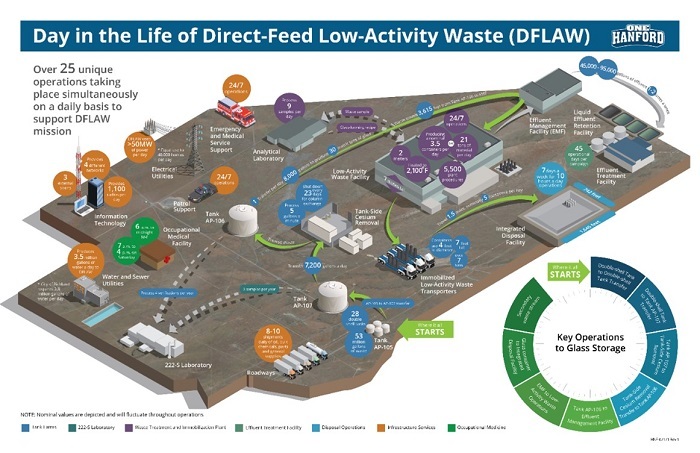 Hanford’s Direct-Feed Low-Activity Waste Program requires integration across all site prime contractors to deliver on more than 25 unique operations to treat waste from large underground tanks. The Technical Integration Team helps the contractors coordinate startup, commissioning and operation of program facilities.
RICHLAND, Wash. – Preparing for 24/7 operations to treat waste from Hanford’s large underground tanks isn’t a one-organization job. EM established the Technical Integration Team to progress the site-wide mission to treat waste under the Direct-Feed Low-Activity Waste ( DFLAW) Program.
All of the site’s prime contractors and multiple EM offices are working together to prepare for starting the vitrification, or immobilization in glass, of waste by the end of next year. The team is made up of a cross section of Hanford Site contractors and EM managers that guide the startup, commissioning and operation of facilities needed to treat and dispose of the waste.
EM Office of River Protection (ORP) tank operations contractor Washington River Protection Solutions (WRPS) recently began operating the Tank-Side Cesium Removal system to remove radioactive solids from waste. After this initial treatment, the waste is being staged in a large underground tank that will feed the waste to the nearby Waste Treatment and Immobilization Plant ( WTP).
Before the waste is sent to the plant in large batches, contractor Hanford Laboratory Management and Integration will test samples of waste pulled from the feed storage tank by vitrifying small batches of the waste in Hanford’s 222-S Laboratory. This is done to ensure the waste meets specifications for treatment in the WTP. Contractor Bechtel National, Inc. (BNI) is commissioning the WTP, where the low-activity waste will be vitrified in large batches inside two giant melters and poured into large containers for disposal.
Contractor Central Plateau Cleanup Company will dispose of the containers in the nearby Integrated Disposal Facility, which provides permanent, environmentally safe disposition for the containers and other low-level waste from Hanford operations. Throughout the process, essential services like water and power are provided by contractor Hanford Mission Integration Solutions.
“The Technical Integration Team has been up and running, meeting every two weeks for a couple of years,” said Mark Gerboth, WRPS mission integration and optimization manager. “We have been focusing on permitting and working with the DOE and regulatory agencies; the status of multiple DFLAW projects; and identifying program risks that will be mitigated to ensure our readiness to operate.”
In addition to preparing for treating tank waste, the team is also focusing on DFLAW operations.
“We’ve set up technical working groups within the team to focus on specific areas of interest in preparing for the startup of waste treatment and 24/7 operations under the DFLAW Program,” said Gerboth.
The working groups get together monthly and exchange ideas and information, including the status of the site-wide DFLAW activities. Members also identify and discuss issues that will be mitigated. The groups cover a wide range of topics, including secondary waste, cybersecurity, nuclear safety, waste feed qualifications, outage planning and even spare parts for 24/7 operations.
“Close collaboration with our Hanford colleagues is making the DFLAW Program successful,” said John Julyk, mission integration manager for BNI at WTP. “When we begin vitrifying tank waste, every step of the mission is important, from engineering through commissioning; treating the waste in Tank Farms and then safely turning it into glass in the WTP; and disposing of the glass-filled containers.”
All of those steps are critical parts of the DFLAW mission, and the One Hanford team is working together to safely treat and dispose of the waste to protect people in the region and the environment.
“This teamwork between the Department of Energy and the Hanford contractors is paramount to the success of the DFLAW Program,” said Delmar Noyes, ORP deputy assistant manager. “The collaboration emphasizes the One Hanford approach, and together, we are laying the foundation for a single contractor operating the DFLAW Program under the future Hanford Integrated Tank Disposition Contract.” -Contributor: Joan Lucas
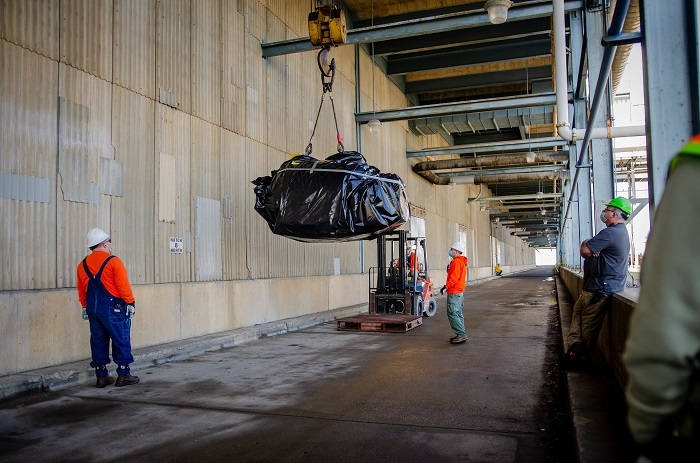 Paducah Site workers with Four Rivers Nuclear Partnership lower motors from the C-333 Process Building’s cell floor to a truck alley below in this 2021 photograph. The motors were relocated to make room for a material segmentation area to support process-gas equipment disposition.
EM recently released contract fee determination scorecards for three contractors that support the cleanup program at the Portsmouth/Paducah Project Office and EM Los Alamos Field Office based on their performance during the evaluation period of fiscal 2021.
To further transparency in its cleanup program, EM releases information relating to contractor fee payments earned by completing the work called for in the contracts.
Portsmouth/Paducah Project Office (PPPO)
PPPO awarded Four Rivers Nuclear Partnership (FRNP), its deactivation and remediation contractor for the Paducah Gaseous Diffusion Plant site in west Kentucky, $7.26 million, or approximately 73.6% of the fee available for its performance for fiscal 2021, which ran from October 2020 through September 2021.
The overall quality and effectiveness of FRNP’s contract performance was “satisfactory,” including in the areas of quality, schedule, cost-control, management and regulatory compliance, and “excellent” in its implementation of business systems, according to the FRNP scorecard.
“I encourage FRNP to take advantage of opportunities for improvement identified during this evaluation while continuing to build on areas of strength,” PPPO Manager Joel Bradburne said.
The prime contractor maintained compliance with standard business systems, accounting practices and applicable regulations. Support to EM in the Federal Facility Agreement processes remained a notable area of accomplishment.
Areas identified for improvement for FRNP include safety and organizational culture; conduct of operations; project integration; consistency of programs and processes across the organization; and certain security requirements. EM’s evaluation also noted that some major scope areas fell behind schedule and were over budget during the performance period.
View the FRNP scorecard here.
Mid-America Conversion Services (MCS), the PPPO depleted uranium hexafluoride (DUF6) conversion contractor, was awarded approximately $4.4 million, or 85.6%, of the available fee for fiscal 2021.
“MCS successfully and safely maintained the DUF6 facilities in a shut down and cooled-down condition during this period, and it has improved management of waste at both sites,” Bradburne said. “MCS continues to cultivate a ‘one-project’ management mindset where lessons learned are distributed across the DUF6 project.”
MCS, which operates DUF6 facilities at the Portsmouth and Paducah gaseous diffusion plant sites in Ohio and Kentucky, received a “good” rating for the quality of its contract performance and regulatory compliance, according to its scorecard. PPPO rated the prime contractor “very good” in the category of schedule; “excellent” for management and use of small business; and “satisfactory” for cost control.
An overall reduction in the MCS open corrective actions and condition reports represents a “very active and effective issues management system,” according to EM’s evaluation. Performance of surveillance, maintenance and plant-modification work at the Portsmouth and Paducah facilities was very good and reflected a strong safety culture.
Quality of some deliverables and proposals required improvement, and there were indications of improvement toward the end of the evaluation period for MCS, according to EM’s evaluation.
View the MCS scorecard here.
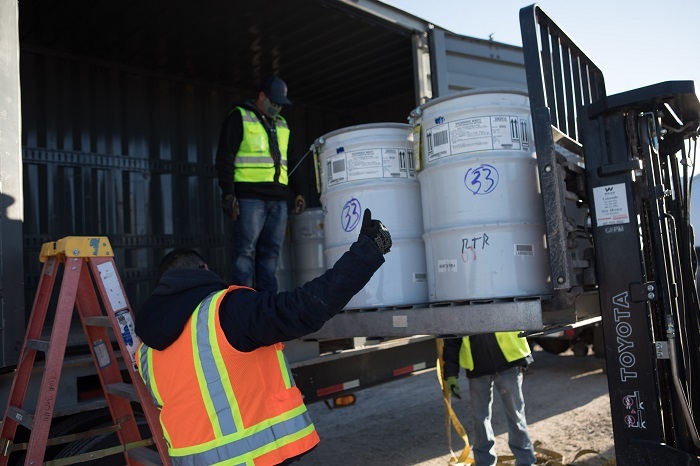 Crews with Newport News Nuclear BWXT-Los Alamos (N3B) load drums with transuranic (TRU) waste for shipment to the Waste Isolation Pilot Plant (WIPP). N3B certified and completed more than 30 legacy TRU waste shipments to WIPP — exceeding an EM 2021 priority.
EM Los Alamos Field Office (EM-LA)
Newport News Nuclear BWXT-Los Alamos (N3B), the EM-LA legacy cleanup contractor at the Los Alamos National Laboratory, earned more than $8.37 million, or 85.7%, of the fee available during fiscal 2021.
“N3B delivered a solid performance based on EM-LA’s evaluation. Their progress in legacy waste operations and safety basis procedures helped to lay a strong foundation for fiscal year 2022,” said Michael Mikolanis, EM-LA manager and the fee determining official. “Another strength identified was N3B’s integration of characterization with the cleanup of the Middle DP Road Site, which resulted in a faster cleanup at less cost for a priority project. And with N3B’s renewed senior management focus on improving performance, I am confident EM-LA will make further advancements on the legacy cleanup with our contractor partner.”
N3B received a rating of “excellent” for regulatory compliance; “good” for quality assurance/safety, schedule and management; and “satisfactory” for cost control, according to its scorecard.
The contractor achieved two significant accomplishments during the period: executing offsite transuranic waste shipments with strong collaboration with the National Nuclear Security Administration and its contractor, Triad National Security, and completing all fiscal 2021 proposed Consent Order milestones with the New Mexico Environment Department.
The N3B scorecard also noted areas for improvement, including occupational safety performance, incurred unnecessary costs for avoidable project delays, and schedule performance.
View the N3B scorecard here.
|